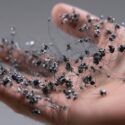The year is 2040. You hunker down with your fellow human survivors, listening for the sound of your enemy. The cyber-bugs have taken over. How did this happen?
What upgrades did the insects receive? And how much damage could they really do?
A cyborg can be defined as, “an organism, often a human, that has certain physiological processes enhanced or controlled by mechanical or electronic devices. But today, we’re going to skip that whole human part and put those upgrades into something a little smaller. We’re talking about insects.
And I’m not just making this up as I go, there’s real research being done when it comes to “upgrading” these miniature operatives.
The Office of Naval Research has experimented with trying to get locusts to sniff out TNT. How? Well, receptor neurons in a locust’s antennae detect chemical odors in the air.
The neurons then send electrical signals to a part of the insect’s brain. This is where we come in. By implanting electrodes into the antennal lobes of the locust, the signals from the antenna can be sent to a computer and analyzed.
Researchers found that different groups of neurons were activated upon exposure to the explosive vapors compared to non-explosive vapors. They also found using data from several locusts together had a better result. When seven locusts were used, their success rate was 80%. Compared to 60% when using just one locust. Teamwork makes the dream work.
And here’s the best part. Insects are cheap and readily available.
It has been estimated there are about 10 quintillion individual insects alive at any given time. And each one is a candidate to be a teeny-tiny agent. But we can use them for good, right?
Well, if we had access to a swarm of cybernetically enhanced insects, they could assist us in all sorts of ways. They could help find people trapped under collapsed buildings, locate explosives, map out large areas, and become nearly undetectable spies.
So, what’s the worst that can happen?
Well, if you’ve seen any sci-fi movie on the subject, you know this won’t end well for us humans. Cyborg insects could be used to disperse deadly viruses and other pathogens, infecting both humans and animals.
This is a horrifying upgrade to the concept of entomological warfare, which already uses insects, such as mosquitos, as weapons. Imagine blanketing the most densely populated city in the world with fleas or a dangerous virus, using cyborg insects. It would spread like a wildfire.
Cyborg insects could also carry recording devices. Talk about invading your privacy. You could be recorded at anytime, anywhere. Even when you are out walking, the moth agents may be listening and watching. So you go and hide inside, but now the cockroach branch has set up a stakeout under your floorboards.
It might be time to invest in some bug spray. But what if we find a way to even the odds? Perhaps we could get some upgrades of our own?
Sources
- “Cyborg — Definition, Examples, Related Words And More At Wordnik”. 2021. wordnik.com.
- “The Pentagon’s Latest Cyborg Insect: Locust Bomb Sniffers”. Atherton, Kelsey. 2021. Forbes.
- “UMMS scientists develop technology to give night vision to mammals”. 2019. University Of Massachusetts Medical School.
- “Will ‘mind-controlled’ drones take off?”. Thompson, Ben. 2016. The Christian Science Monitor.
- “The Future Is Here: Six Of Today’s Most Advanced, Real-Life Cyborgs”. 2021. Futurism.
- “Cyborg grasshoppers have been engineered to sniff out explosives”. Lu, Donna. 2021. New Scientist.



























